Budha (Mandsaur, Madhya Pradesh): Some 300 km north-west of capital Bhopal, in the heart of India, amidst dense neem trees, is a courtyard that could determine the electoral fate of this state–and the events that unfolded here explains why farmers marched to Mumbai, Delhi and Kolkata in the last week of November 2018.
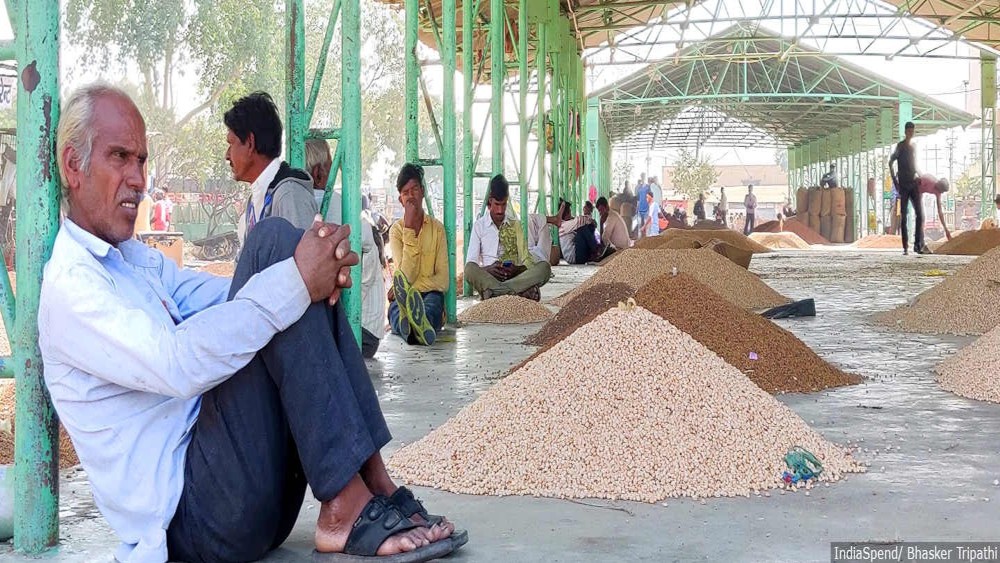
A farmer waits for his turn to sell his produce at Mandsaur agriculture produce market in MP
The courtyard here in Budha village was the epicentre of the 2017 farmers’ protests across Madhya Pradesh (MP) –a state that depends on agriculture for 30% of its income and reported 10.9% annual growth in its agricultural sector for eight years to 2015–India’s fastest.
The protest spiralled out from Budha and turned violent after six farmers were killed as police fired on them at Mandsaur. It has been a rallying point for the farmers’ movement in MP ever since. These farmers were demanding higher minimum support prices (MSP)–the subsidies the government pays them to offset low market prices–and loan waivers, demands that are now common nationwide.
At the core of the farm protests sweeping MP lies a deeper crisis– a fractured farm economy, where 46% of households are indebted. As many as 1,321 farmers committed suicide in MP in 2016, the highest since 2013, according to the government data presented in Lok Sabha on March 20, 2018. While farm suicides dropped by 10% elsewhere in the country in two years to 2016, MP saw a 21% jump.
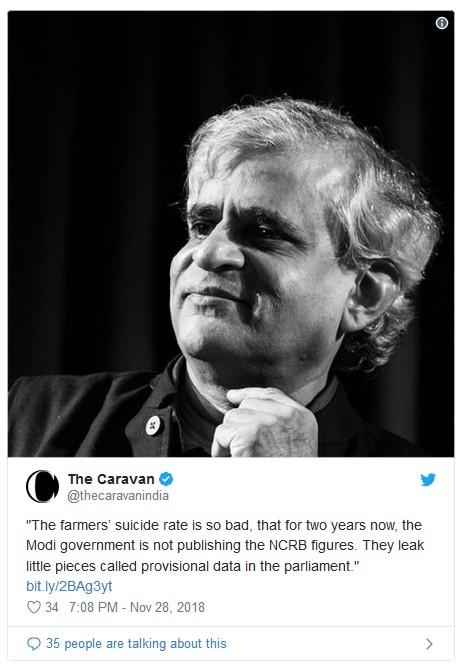
The story of MP’s farmers is the story of India’s farmers in an era of record harvests. India grew more foodgrain in 2017 than ever before, and the government’s agriculture budget rose 111% over four years to 2017-18, as IndiaSpend reported in January 2018. Yet prices crashed, unpaid agricultural loans grew 20% over the year to 2017, and 600 million Indians who depend on farming struggled to get by.
India was swept by about a dozen major farm protests in 2018, with thousands of farmers travelling to Delhi, Kolkata and Mumbai in the last week of November 2018 alone.
On November 29, 2018, more than 100,000 farmers from many states and more than 200 farm organisations streamed in to Delhi. They gathered at the Ramlila maidan, site for protests and celebrations over decades, demanding a special parliamentary session and the passage of two private members’ bills–also known as Kisan Mukti bills (farmer freedom bills). These propose that MSP be made a legal requirement, the government buy all harvested crops and a debt relief commission be established to hold off debt recovery for up to three years in distressed areas and reschedule and waive certain loans.
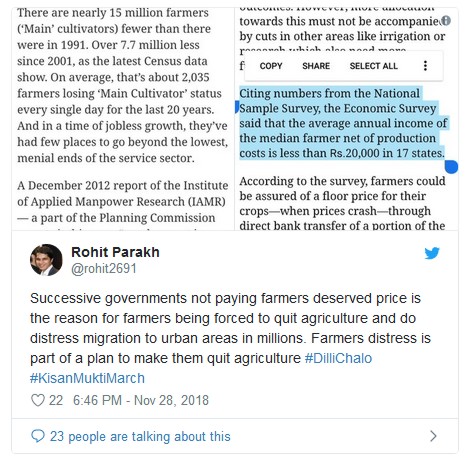
The same day, more than 1,000 km east in Kolkata, farmers from across the state of West Bengal gathered to demand loan waivers and the establishment of industries on farm land taken over by the government.
Underlying these protests are data that reveal the decline in India’s agriculture economy: The number of farmers dipped by over 8.6 million over 10 years to 2011, according to Census 2011, and the number of farm labourers increased by more than 37 million. The number of small and marginal farmers–with farms smaller than 5 acres or the size of four football fields–rose by 27 million over 15 years to 2015-16 to reach 126 million, as per the latest agriculture census.
Nearly 70% of India’s 90 million agricultural households spend more than they earn on average each month, pushing them towards debt, the primary reason for more than half farmer suicides recorded nationwide, IndiaSpend reported on June 27, 2017. Over 10 years to 2016, more than 142,000 farmers committed suicide in India.
“Farmers have been working quietly without ever complaining all these years, but how long can we wait for governments to turn their attention to us?” Hariom Patidar (39), one of the farmers gathered in the courtyard in Budha on November 13, 2018, told IndiaSpend. “So we are demanding it now”.
The courtyard where half a dozen farmers had gathered has seen more than a dozen gatherings of hundreds of farmers over October and November 2018. The agenda of the meetings remained the same: Urging farmers in MP and across India to choose governments sensitive to farmers in both the state elections and in the 2019 general elections.
Unrest over low remunerative prices and uncertain claim settlements under a national crop insurance scheme could hurt the popularity of BJP–currently the ruling party–in the upcoming 2019 general elections, said farmers gathered on the courtyard in Budha.
Food and trade analyst Devinder Sharma said that successive governments have been trying to push farmers out of agriculture. “For them, the best way (to do this) is to make agriculture economically unviable,” he said.
In Madhya Pradesh, agriculture gets only 6.7% of the state’s budget. Of the state’s own revenues, 87% goes towards payment of salaries, pensions and dealing with interest obligations, said Sharma. Other states also spend a large proportion of their revenues on salaries, pensions and interests payments — Chhattisgarh (92%), Punjab (88%) and Rajasthan (115%), for example, he pointed out.
All of these states are heavily dependent of farm economy but where is the investment for farmers? asked Sharma.
Small farmers have been the worst-hit by the crop price crash. They have no safety nets like institutional credit and savings to protect them against such shocks. We followed one such farmer from his farm to the mandi to understand why market forces are loaded against small cultivators.
Why Girdhari Lal’s onion harvest sold at just Rs 1.20 a kilo
A resident of Dalawada village in Mandsaur, Girdhari Lal (55) is a marginal farmer — a category of cultivators who own no more than 2.5 acres of land, the size of two football fields combined. On November 13, 2018, he stood loading 5 quintals of onions, reaped the day before, onto a shared truck to take it to the Mandsaur agriculture produce market, 40 km away. This is one of the biggest agriculture markets for onions in the country.
Lal spent the entire night waiting for market officials to arrive and fix the price for his onions. Short of sleep, with just a samosa and cup of tea to keep him going for over eight hours, he sat with his produce scattered around him on an open ground in the market.
It was almost noon when an official of the market, surrounded by a bunch of traders, walked in. He inspected every onion mound, mentioned a basic bidding rate and soon as he heard a bigger number from the traders, signed the official slip to sell the pile.
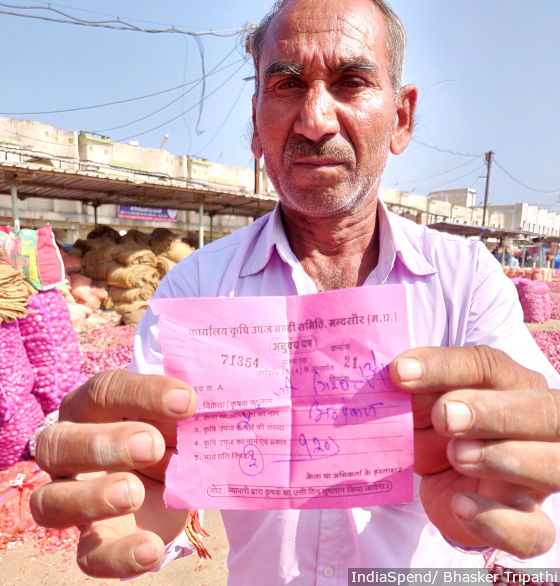
Girdhari Lal (55), a marginal farmer, sold his onions for Rs 1.20 per kg, after spending Rs 6 per kg to grow and harvest them.
The official then walked up to Lal’s produce. “120… 120…120,” the bidding began. And stopped, no one had come up with a higher rate. “Rate per quintal: [Rs] 120”: read the pink slip handed to Lal.
Lal got Rs 600 for a harvest that took four months of work, Rs 1.20 per kilo. Since transportation had cost Rs 60 a quintal, all that he took home from the market that day was Rs 300, or 60 paise a kg. He had hoped for at least Rs 15 a kg, said Lal.
“It does not even cover what I owe the labourers, let alone my family expenses,” he said, his voice calm despite the disappointment. “This is our [farmer’s] fate… we will die struggling to barely manage a meal for our family.”
The issue of fair remunerative prices is agitating farmers across India.
“If the MSP has been announced, why are we forced to sell our crops below that? Is it not what it means… a ‘minimum price’ for a crop?” said Hariom. To explain their despair with the current agriculture market, the farmers did the calculations for IndiaSpend on a sheet of paper.
MP’s farmers have suffered losses in most major kharif crops in 2018. The worst-hit were soybean and black gram — where losses were to the extent of 30%. The state contributes 31% and 25% respectively of the national output of these crops.
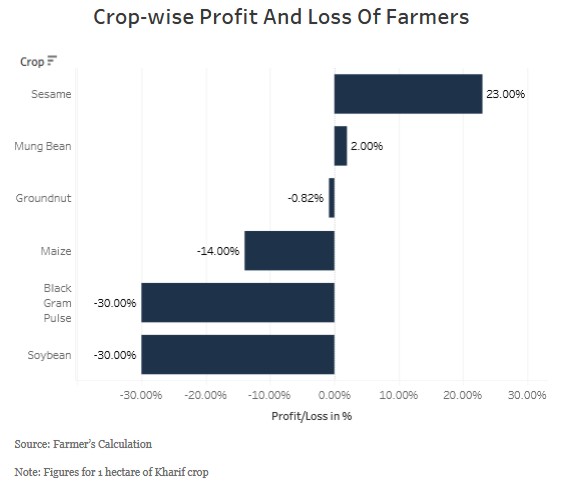
Mung bean and sesame fetched some profit but at margins that are “not enough”, according to the farmers. Also these profits were calculated on a ‘maximum realised price’ which they do not get very often, they said.
The sesame crop takes 90-100 days to mature, so if one hectare of crop fetches a profit of Rs 9,000, it gets an entire farmer family Rs 90/day. This is even less than what a farm labourer earns, pointed out Dileep Patidar (43), a farmer from Budha.
Despite a 9.4% growth in the state’s agriculture GDP over 15 years to 2014-15– far better than the national average of 3.3% between 2000-01 and 2012-13 — the average monthly income of an agricultural household in MP is Rs 6,210, which lags behind the national average of Rs 6,426 (July 2012-June 2013), Mint reported in June 2017.
Farmers should at least fetch Rs 4,500-5,000 for soybean, more than Rs 3,300 for garlic and Rs 1,500-1,800 for onions, if they want to make any profit, but this seems impossible, Dileep said.
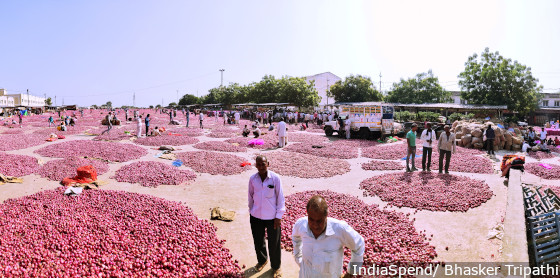
Onions pile up in MP’s Mandsaur agriculture market. They sold for a 1/5th of what it cost to grow them.
Bhavantar Yojna: Why farmers are unhappy with the govt price scheme
After the June 2017 Mandsaur protest, the BJP government in the state adopted a different approach towards price support for farmers. It launched the Mukhya Mantri Bhavantar Bhugtan Yojna (chief minister’s price difference payment scheme) commonly known as the Bhavantar Yojna in October 2017. The scheme, pitched by the BJP as a game-changer, pays farmers the difference between the market price and the MSP if the market is depressed.
“Bhavantar Bhugtan Yojna is proving to be a boon for the farmers of MP, getting them fair prices,” chief minister Shivraj Singh Chauhan said at a public rally in January 2018.
“Boon? It is a curse for farmers,” retorted Bharat Patidar (35), a farmer in Budha. “We were happy to hear about the yojna but we eventually realised it has many flaws.”
In the 2018 kharif (monsoon crop) season, Bharat had sown urad or black gram pulse on a larger acreage in his fields expecting good returns. But his name was excluded from the list of those entitled to sell their crop under the scheme because of an alleged mix-up in the revenue department’s registration process.
“The revenue department official without even coming on my farm to survey, fraudulently registered my crop as soybean on papers instead of urad,” Bharat said. “So my produce did not match the revenue department’s papers.”
The farmer, distressed by the thought of losing thousands of rupees, tried to explain his plight to the officials. “Nobody listened, never heard back from them,” he said. “I had to sell my produce at a very low rate in the market. It was a huge loss for me, I had taken a big loan.”
Farmers pointed out another problem with the Bhavantar Yojna — it takes into account the average produce per hectare decided by the revenue department after a survey. So, if a farmer grows 12 quintal in a hectare and the revenue department’s average yield is 7 quintal per hectare, he will be eligible only for benefits in line with the government average.
With 8 hectares of land, Bharat is a medium-scale farmer, among the only 4% in this category in the state where small and marginal holdings dominate (80%), according to a 2016 report by the central agriculture ministry. Small and marginal farmers anyway find it hard to benefit from the scheme.
“The government usually flags off the Bhavantar Yojna a month into the harvest season,” said Hariom. “This one-month gap excludes most small and marginal farmers from the scheme because most of them sell their produce in this period — they need instant cash to repay their debts and prepare for the next crop.”
The scheme is applicable for just two months during the crop marketing season. This means that most of the season’s produce lands up in the market during this two-month window sending prices crashing, said Kedar Sirohi, president of Kisan Congress, a farmers’ collective, MP.
If the government were to allow this scheme to continue throughout the year farmers could store their produce and sell it when the market is strong, suggested Sirohi. “This will also reduce the burden on the taxpayer whose money is used for funding the scheme,” he said.
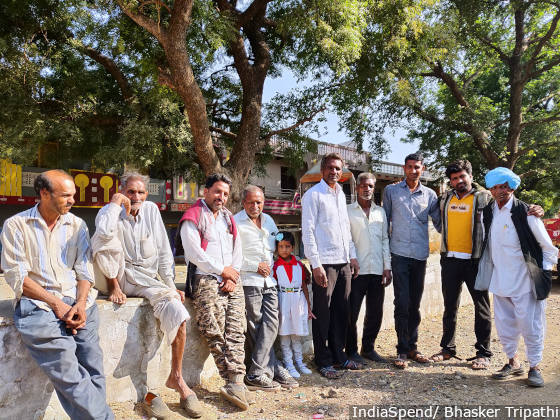
A group of farmers gathered in a courtyard in Budha village in Mandsaur district of MP. The courtyard was the epicenter of farm protests in 2017.
Also, the government does not pay for the entire difference between the MSP and the realised price.
“Let’s take an example of the garlic crop which is coming into the markets these days,” Dileep said. “It is selling at Rs 200 per quintal whereas the declared MSP is Rs 3,200. Going by the name of the scheme the government should pay the farmer the remaining Rs 3000 but then the government has capped the payable sum at Rs 800 per quintal”.
The “cap” Dileep referred is mentioned in the fine-print of the scheme — the government will only pay the difference between the average price, not actual market price the farmer gets, and the MSP. In the case of garlic, the government took the average market price as Rs 2,400. Thus, even after availing the scheme and getting Rs 800 from the government, a farmer who sold his garlic crop at Rs 200 in the market, will still lose about Rs 2,200 on every quintal.
While adding the average market price clause, the government did not take into account the likelihood of traders colluding to keep prices down. A few months after the launch of the scheme, traders allegedly hammered down the average price of the crops like soybean and black gram pulse by buying at rates lower those in the market, Scroll.in reported in June 2018.
“The fate of the farmers has not changed much; we are selling milk at Rs 18-22 per litre while it used to sell at Rs 30-35/litre a few years back and other produce like soybean at a loss of 20-30%,” Dileep said.
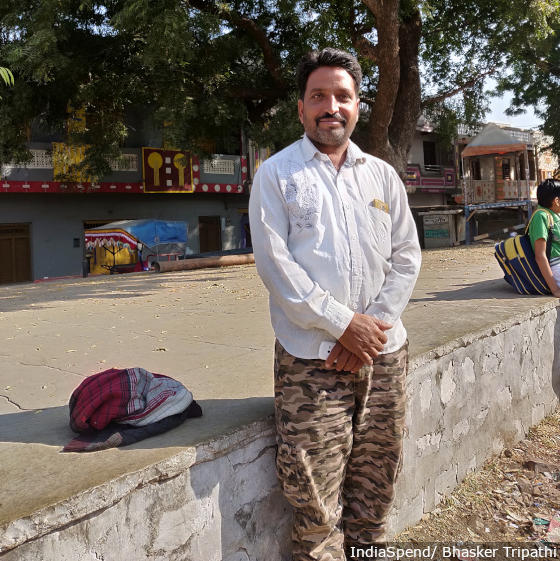
Deelip Patidar, a farmer who took part in the 2017’s farmers’ protest in Mandsaur.
Why farmers are unhappy with crop insurance
Bharat Patidar is insured under the Pradhan Mantri Fasal Beema Yojna (PMFBY) or Prime Minister Crop Insurance Scheme since it was launched in 2016, but he has not benefitted from it even once so far, he said.
During the last kharif crop, Rs 11,000 were deducted from Bharat’s account for the insurance. So when the production was low due to lack of rainfall, he was hoping to get the claim under the insurance.
“To my surprise, a farm adjacent to mine, but falling under a neighbouring village Limbawas, received the claim but I did not,” Bharat said. “When I asked around in the farmer’s network, I realised that the claims were only settled in villages with small number of farmers and all the large villages were excluded. What kind of logic is this?”
In the villages which received claims this kharif season, compensations were different even in neighbouring villages. Rinchha village in Mandsaur received a compensation of Rs 7,000 per hectare but Barujana next door got only Rs 1,500 per hectare, Dileep told IndiaSpend.
MP has the the third largest number of farmers insured under PMFBY and the Restructured Weather Based Crop Insurance Scheme (RWBCIS) combined during kharif 2017– 3.5 million. Maharashtra with 8.7 million farmers and Rajasthan with 5.3 million farmers held the first and second positions, according to the scheme’s online portal.
However, no more than 46% of insured farmers in MP received their claims, as per data.

Source: Pradhan Mantri Fasal Beema Yojna Portal
Data for Kharif 2017 (PMFBY and RWBCIS Combined Till Oct 1, 2018]
What the farm crisis could mean for BJP’s popularity in MP
About 75% of the more than 50 million voters in MP — 70% of the working population in the state survives on agricultural income — turned up at 65,000 polling stations on November 28, 2018, to choose their next government.
The results will be declared on December 11, 2018 but here are what pre-poll surveys showed: A Times Now survey—before exit polls were banned till December 7, 2018–suggested that the Shivraj Singh Chouhan government will bag a fourth-term in MP. BJP could win 122 of 230 seats, crossing the halfway-mark, said the poll.
A couple of other exit polls, done earlier this year, predicted a Congress win. The party will get a 49% vote share and BJP 34%, said the May 2018 joint survey conducted by Lokniti, the Centre for Developing Societies (CSDS) and ABP. A poll by CVoter and ABP in August 2018 predicted a 42% vote share for the Congress and 40% for the BJP. A second poll by Lokniti-CSDS-ABP done more recently in October 2018, however, suggested that BJP (41%) will take a one-point lead over the Congress (40%) in MP.
Whatever the results, it is clear that the farm crisis has impacted the BJP’s popularity in the state and the party’s campaigners admit as much.
“Bhavantar Yojna is a good scheme but the farmers’ have been complaining that process to avail money under this scheme is complicated,” said Nihar Chand, a member of the BJP’s state working committee who has been campaigning in Mandsaur. “Farmers also question us about the irregularities in the crop insurance scheme, about the frauds committed by revenue officials in surveys.”
BJP campaigners had gone from village to village trying to convince farmers that their problems would be resolved soon. Farmers appear unconvinced.
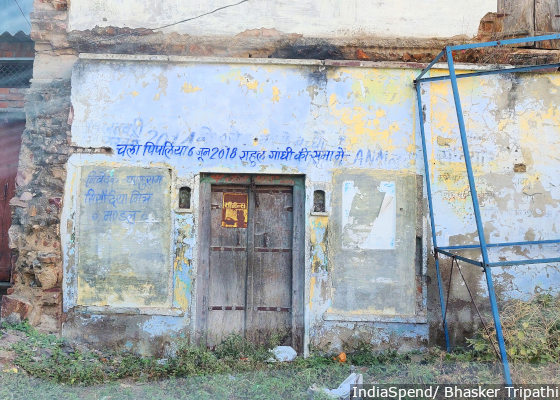
A dilapidated building reads a message to farmers of Budha village in Mandsaur district of MP.
This government talks about Hindu-Muslim issues, the Ram Mandir in Ayodhya, but they never utter a single word about MSP, they do not feel responsible for the farmers’ distress, said Hariom. “I am going to vote for the party which will make farmers’ issues its priority, and the Congress party seems to be doing that in their campaign,” he said.
Bharat warned politicians against underestimating the political strength of farmers. “Today farmers are educated enough to understand that their leaders have wronged them,” he said. “They will sit on dharna, block roads, fast unto death, do whatever they can to to be heard and get what they deserve,” he said.
(Tripathi is a principal correspondent with IndiaSpend.)
Courtesy: India Spend